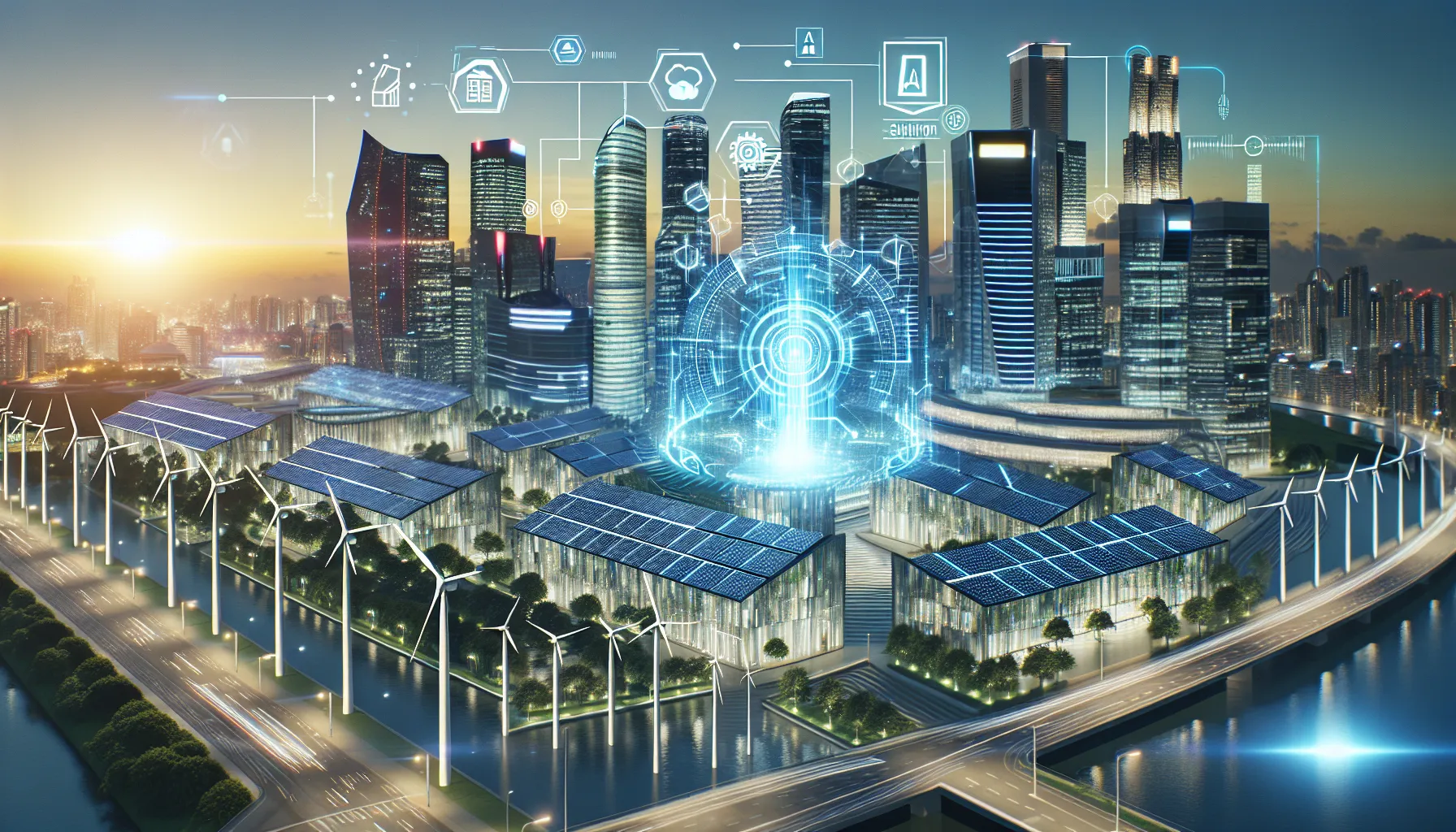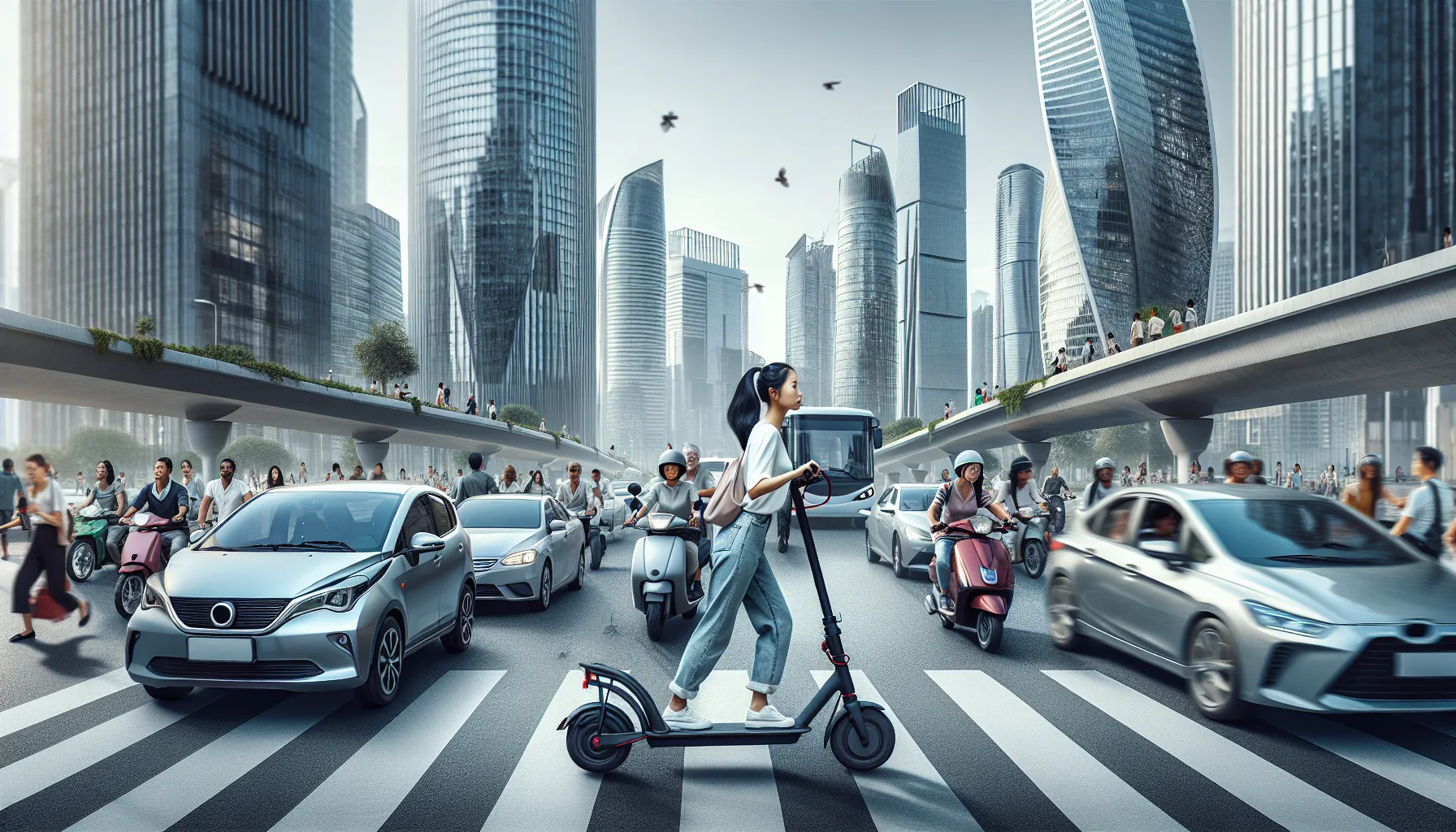As an experienced IELTS instructor, I’m excited to share with you a comprehensive IELTS Reading practice test focusing on the fascinating topic of “How AI is Supporting Energy-Efficient Building Designs.” This test will not only help you prepare for the IELTS exam but also provide valuable insights into the innovative ways artificial intelligence is revolutionizing sustainable architecture.
Nội dung bài viết
- Introduction
- IELTS Reading Practice Test
- Passage 1 – Easy Text
- The Rise of AI in Sustainable Architecture
- Questions 1-5
- Questions 6-10
- Passage 2 – Medium Text
- AI-Driven Innovations in Energy-Efficient Architecture
- Questions 11-14
- Questions 15-20
- Passage 3 – Hard Text
- The Symbiosis of AI and Sustainable Architecture: Challenges and Future Prospects
- Questions 21-26
- Questions 27-30
- Questions 31-35
- Answer Key
- Passage 1
- Passage 2
- Passage 3
 AI in Sustainable Architecture
AI in Sustainable Architecture
Introduction
The IELTS Reading test consists of three passages of increasing difficulty, followed by a series of questions designed to assess your reading comprehension skills. In this practice test, we’ll explore how artificial intelligence is transforming the landscape of energy-efficient building designs, a topic that’s becoming increasingly relevant in our eco-conscious world.
IELTS Reading Practice Test
Passage 1 – Easy Text
The Rise of AI in Sustainable Architecture
Artificial Intelligence (AI) is rapidly transforming various industries, and the field of architecture is no exception. In recent years, AI has emerged as a powerful tool in designing energy-efficient buildings, revolutionizing the way architects approach sustainable design. By leveraging machine learning algorithms and big data analysis, AI can optimize building performance, reduce energy consumption, and minimize environmental impact.
One of the primary ways AI supports energy-efficient building designs is through predictive modeling. Advanced AI systems can analyze vast amounts of data, including weather patterns, occupancy rates, and energy usage trends, to create accurate simulations of a building’s performance over time. This allows architects and engineers to make informed decisions about design elements such as insulation, window placement, and HVAC systems before construction even begins.
Moreover, AI-powered generative design tools are enabling architects to explore countless design possibilities in a fraction of the time it would take using traditional methods. These tools can generate hundreds or even thousands of design variations based on specific parameters, such as energy efficiency goals, site constraints, and budget limitations. By rapidly iterating through design options, architects can identify the most optimal solutions for energy-efficient buildings.
Another significant contribution of AI to sustainable architecture is in the realm of building management systems. Smart buildings equipped with AI-driven control systems can continuously monitor and adjust various factors such as lighting, heating, cooling, and ventilation in real-time. These systems learn from occupant behavior and environmental conditions to optimize energy usage while maintaining comfort levels, resulting in substantial energy savings over the building’s lifetime.
As AI technology continues to advance, its role in supporting energy-efficient building designs is expected to grow even further. From enhancing the design process to optimizing ongoing building operations, AI is proving to be an invaluable ally in the quest for more sustainable and environmentally friendly architecture.
Questions 1-5
Do the following statements agree with the information given in the passage?
Write:
TRUE if the statement agrees with the information
FALSE if the statement contradicts the information
NOT GIVEN if there is no information on this
- AI is only being used in the architecture industry.
- Predictive modeling allows architects to make informed decisions before construction begins.
- Generative design tools can produce thousands of design variations quickly.
- AI-driven building management systems can only control lighting in buildings.
- The use of AI in energy-efficient building design is expected to decrease in the future.
Questions 6-10
Complete the sentences below.
Choose NO MORE THAN TWO WORDS from the passage for each answer.
- AI uses __ __ algorithms to optimize building performance.
- AI systems can analyze data including weather patterns, occupancy rates, and __ __ trends.
- Generative design tools allow architects to explore design possibilities based on parameters such as energy efficiency goals, site constraints, and __ __.
- Smart buildings with AI-driven control systems can adjust factors like lighting and heating in __ __.
- AI-driven systems in buildings learn from __ __ and environmental conditions to optimize energy usage.
Passage 2 – Medium Text
AI-Driven Innovations in Energy-Efficient Architecture
The integration of Artificial Intelligence (AI) into the realm of energy-efficient building design has ushered in a new era of architectural innovation. This paradigm shift is not merely about incorporating smart technologies into buildings; it represents a fundamental change in how we conceptualize, design, and operate sustainable structures. AI’s capacity to process and analyze vast amounts of data is proving instrumental in addressing the complex challenges of creating buildings that are both environmentally friendly and energy-efficient.
One of the most significant advancements brought about by AI is in the field of thermal modeling. Traditional methods of predicting a building’s thermal performance often relied on simplified assumptions and static data. In contrast, AI-powered thermal modeling tools can create dynamic simulations that account for a multitude of variables, including changing weather patterns, occupant behavior, and the thermal properties of different materials. This level of precision allows architects and engineers to fine-tune their designs for optimal energy efficiency.
Moreover, AI is revolutionizing the concept of adaptive facades. These are building exteriors that can change their properties in response to environmental conditions. AI algorithms can analyze real-time data from sensors embedded in the facade, adjusting elements such as shading devices, ventilation systems, and even the transparency of windows to optimize energy usage and occupant comfort. For instance, an AI system might automatically tint windows to reduce solar gain during peak sunlight hours or adjust louvers to maximize natural ventilation when outdoor temperatures are favorable.
In the realm of urban planning, AI is proving to be an invaluable tool for creating energy-efficient cities. By analyzing data on factors such as population density, traffic patterns, and energy consumption, AI can help urban planners make informed decisions about building placement, orientation, and design. This holistic approach ensures that individual buildings not only perform efficiently on their own but also contribute to the overall energy efficiency of the urban environment.
AI is also transforming the way we approach retrofitting existing buildings for improved energy efficiency. Machine learning algorithms can analyze a building’s historical energy consumption data, identify inefficiencies, and suggest targeted improvements. This data-driven approach allows for more cost-effective and impactful retrofitting strategies, potentially extending the lifespan of older buildings while significantly reducing their energy footprint.
Furthermore, AI is enhancing the capabilities of Building Information Modeling (BIM) systems. By integrating AI into BIM, architects and engineers can create more accurate and detailed digital twins of buildings. These AI-enhanced models can simulate various scenarios, predict maintenance needs, and optimize building performance throughout its lifecycle. This not only improves energy efficiency during the operational phase but also aids in making more sustainable choices during the design and construction phases.
As AI continues to evolve, its potential to support energy-efficient building designs grows exponentially. From generative design algorithms that can create novel, highly efficient structural forms, to predictive maintenance systems that can anticipate and prevent energy-wasting equipment failures, the applications of AI in sustainable architecture are vast and expanding. This technological revolution promises not only to reduce the environmental impact of our built environment but also to create spaces that are more responsive, efficient, and attuned to human needs.
Questions 11-14
Choose the correct letter, A, B, C, or D.
-
According to the passage, AI’s integration into energy-efficient building design represents:
A) A minor technological update
B) A fundamental change in architectural approach
C) A temporary trend in the industry
D) A cost-saving measure for construction companies -
AI-powered thermal modeling tools differ from traditional methods by:
A) Using only static data
B) Relying on simplified assumptions
C) Creating dynamic simulations with multiple variables
D) Focusing solely on weather patterns -
Adaptive facades utilizing AI can:
A) Change color for aesthetic purposes
B) Automatically adjust to optimize energy usage
C) Reduce construction costs
D) Eliminate the need for windows -
In urban planning, AI helps create energy-efficient cities by:
A) Replacing human planners entirely
B) Focusing only on individual building efficiency
C) Analyzing various urban factors for informed decision-making
D) Designing all buildings to look identical
Questions 15-20
Complete the summary below.
Choose NO MORE THAN TWO WORDS from the passage for each answer.
AI is revolutionizing energy-efficient architecture in numerous ways. It enables more precise (15)__ __ through dynamic simulations. AI also powers (16)__ __ that can adjust to environmental conditions. In urban planning, AI assists in creating energy-efficient cities by analyzing data on various factors. For existing buildings, AI can identify inefficiencies and suggest improvements for (17)__ __. The integration of AI with (18)__ __ __ (BIM) systems allows for the creation of detailed digital twins, improving building performance throughout its lifecycle. Additionally, AI is being used in (19)__ __ algorithms to create novel structural forms and in (20)__ __ systems to prevent equipment failures, further enhancing energy efficiency in buildings.
Passage 3 – Hard Text
The Symbiosis of AI and Sustainable Architecture: Challenges and Future Prospects
The inexorable march of Artificial Intelligence (AI) into the domain of sustainable architecture has precipitated a paradigm shift in how we conceptualize, design, and operationalize energy-efficient buildings. This technological revolution, while promising unprecedented advancements in building performance and environmental sustainability, also presents a complex tapestry of challenges that must be navigated with judicious consideration.
One of the most salient benefits of AI in sustainable architecture is its capacity for holistic optimization. Unlike traditional design methodologies that often address energy efficiency through isolated interventions, AI-driven systems can simultaneously analyze and optimize myriad interdependent factors. These include thermal dynamics, daylighting, natural ventilation, occupant behavior patterns, and even the building’s interaction with its urban context. This comprehensive approach allows for the creation of buildings that are not merely assemblages of energy-efficient components, but integrated ecosystems that synergistically maximize overall performance.
However, the implementation of AI in architectural design is not without its attendant challenges. One significant hurdle is the “black box” phenomenon, wherein the decision-making processes of advanced AI algorithms become opaque and difficult to interpret. This lack of transparency can be problematic in an industry where design decisions must often be justified to clients, regulatory bodies, and the public. Moreover, it raises ethical questions about the role of human creativity and intuition in architectural design, and whether an over-reliance on AI might lead to a homogenization of architectural solutions.
Another critical consideration is the data dependency of AI systems. The efficacy of AI in optimizing energy-efficient designs is predicated on the availability of vast, high-quality datasets. However, in many contexts, such data may be scarce, inconsistent, or subject to privacy concerns. This data scarcity can potentially lead to biased or suboptimal design outcomes, particularly in regions or for building typologies that are underrepresented in existing datasets.
The integration of AI with existing architectural workflows and tools also presents technical and cultural challenges. Many architectural firms, particularly smaller practices, may lack the technical expertise or resources to effectively implement and maintain advanced AI systems. Furthermore, there may be resistance from architects who view AI as a threat to their professional autonomy or creative expression.
Despite these challenges, the future prospects of AI in sustainable architecture are exceedingly promising. Emerging technologies such as federated learning and explainable AI (XAI) are addressing issues of data privacy and algorithmic transparency. Federated learning allows AI models to be trained on distributed datasets without centralizing sensitive information, potentially expanding the pool of available data while preserving privacy. XAI techniques, on the other hand, aim to make AI decision-making processes more interpretable and understandable to human users.
Moreover, the ongoing development of AI-enhanced generative design tools is opening up new frontiers in architectural creativity. These tools can generate countless design variations based on specified parameters, allowing architects to explore innovative forms and solutions that might not have been conceivable through traditional design processes. This symbiosis of human creativity and machine intelligence has the potential to produce architectural solutions that are both aesthetically compelling and highly optimized for energy efficiency.
Looking ahead, the convergence of AI with other emerging technologies such as the Internet of Things (IoT), advanced materials science, and digital fabrication techniques promises to further revolutionize sustainable architecture. Imagine buildings with AI-driven adaptive facades that can reconfigure in real-time to optimize energy performance, or structures that can self-diagnose and heal minor damages to maintain peak efficiency over time.
In conclusion, while the integration of AI into sustainable architectural practice presents significant challenges, its potential to dramatically enhance building energy efficiency and environmental performance is undeniable. As we navigate this technological frontier, it is imperative that we strike a balance between embracing the transformative power of AI and preserving the human-centric values that are fundamental to good architecture. The future of sustainable building design lies not in the wholesale replacement of human architects with AI, but in the thoughtful symbiosis of artificial and human intelligence, working in concert to create built environments that are both energy-efficient and enriching to human experience.
Questions 21-26
Complete the sentences below.
Choose NO MORE THAN TWO WORDS from the passage for each answer.
- AI-driven systems in sustainable architecture allow for __ __ of multiple interdependent factors simultaneously.
- The __ __ phenomenon in AI algorithms can make it difficult to explain design decisions to stakeholders.
- The effectiveness of AI in optimizing energy-efficient designs depends on the availability of large, high-quality __.
- __ __ is a technology that allows AI models to be trained on distributed datasets without centralizing sensitive information.
- __ __ techniques aim to make AI decision-making processes more understandable to humans.
- The future may see buildings with AI-driven __ __ that can reconfigure in real-time for optimal energy performance.
Questions 27-30
Do the following statements agree with the claims of the writer in the passage?
Write:
YES if the statement agrees with the claims of the writer
NO if the statement contradicts the claims of the writer
NOT GIVEN if it is impossible to say what the writer thinks about this
- The implementation of AI in architectural design is straightforward and without significant challenges.
- Smaller architectural firms may struggle to implement and maintain advanced AI systems due to lack of resources or expertise.
- AI-enhanced generative design tools limit architectural creativity.
- The future of sustainable building design involves a complete replacement of human architects with AI systems.
Questions 31-35
Choose the correct letter, A, B, C, or D.
-
According to the passage, one of the main advantages of AI in sustainable architecture is:
A) Its ability to work independently of human input
B) Its capacity for holistic optimization of multiple factors
C) Its focus on aesthetic design over energy efficiency
D) Its simplification of the architectural design process -
The “black box” phenomenon in AI refers to:
A) The physical appearance of AI systems
B) The opacity of AI decision-making processes
C) The color of energy-efficient buildings
D) The storage of architectural data -
The author suggests that the data dependency of AI systems in architecture:
A) Is not a significant issue
B) Can potentially lead to biased or suboptimal design outcomes
C) Only affects large-scale projects
D) Is easily solved with current technology -
The passage indicates that the future of AI in sustainable architecture will likely involve:
A) Complete automation of the design process
B) A symbiosis of artificial and human intelligence
C) The obsolescence of traditional architectural skills
D) A focus solely on energy efficiency at the expense of aesthetics -
The author’s overall attitude towards the integration of AI in sustainable architecture can be described as:
A) Highly skeptical
B) Neutral and disinterested
C) Cautiously optimistic
D) Unconditionally enthusiastic
Answer Key
Passage 1
- FALSE
- TRUE
- TRUE
- FALSE
- FALSE
- machine learning
- energy usage
- budget limitations
- real-time
- occupant behavior
Passage 2
- B
- C
- B
- C
- thermal modeling
- adaptive facades
- retrofitting
- Building Information Modeling
- generative design
- predictive maintenance
Passage 3
- holistic optimization
- black box
- datasets
- Federated learning
- Explainable AI
- adaptive facades
- NO
- YES
- NO
- NO
- B
- B
- B
- B
- C
This IELTS Reading practice test demonstrates how AI is revolutionizing energy-efficient building designs. The passages cover various aspects of AI’s role in sustainable architecture, from basic concepts to more complex applications and future prospects. By practicing with these materials, you’ll not only improve your reading skills but also gain valuable insights into this cutting-edge field.
For more information on related topics, you might find these articles interesting:
- How Green Buildings are Promoting Sustainable Urban Living
- The Role of Green Buildings in Urban Sustainability
- How to Create a Sustainable City
Remember, consistent practice with diverse reading materials is key to improving your IELTS Reading score. Good luck with your studies


